Squids' birthday influences mating: Male spear squids shown to become 'sneakers' or 'consorts' depending on birth date
The day a male spear squid hatches determines which mating tactic he will use throughout his life, according to new research. Spear squid (Heterololigo bleekeri) that hatch earlier in the season become "consorts" that fight ...









